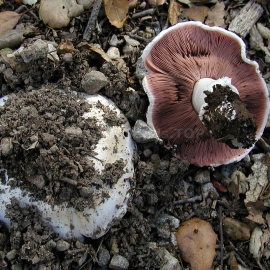 EXCLUSIVE
EXCLUSIVE


Salt-loving mushroom / Agaricus Bernardii - Organic Mushroom's Dry Mycelium
6.10 €
Fruit bodies of Agaricus bernardii have caps that range in shape from convex to flattened, and reach a diameter of 5–15 cm (2.0–5.9 in). The cap surface is dry and smooth, with a white or buff color that can develop brownish spots in maturity.
-
Organic Salt-loving Mushroom's Dry Mycelium
Fruit bodies of Agaricus bernardii have caps that range in shape from convex to flattened, and reach a diameter of 5–15 cm (2.0–5.9 in). The cap surface is dry and smooth, with a white or buff color that can develop brownish spots in maturity. In age, the surface often forms scales or warts.
The flesh is thick, firm, and stains reddish-orange or reddish-brown when cut, although this reaction can be slow to develop. Its odor ranges from mild to briny to pungent. The gills are free from attachment to the stem, and packed close together. Initially grayish-pink to pinkish, they turn reddish-brown and then chocolate brown as the spores mature.
The stem is solid (i.e., not hollow), firm, and measures 4–10 cm (1.6–3.9 in) long by 2–4 cm (0.8–1.6 in) thick. A thick, white, rubbery partial veil covers the gills of the immature mushroom, and eventually remains as a ring on the middle of the stem.
Although the mushrooms sometimes have an odor that is briny or pungent ("though not inappropriate"), they are edible and good. David Arora compares its taste to that of the closely related Agaricus bitorquis, "but a little chewier and sometimes with a slightly salty or briny taste."
Agaricus bernardii mushrooms produce a dark brown spore print. The spores are smooth, broadly elliptical, and have dimensions of 6–7.5 by 5–6 сm. The basidia (spore-bearing cells) are four-spored and club-shaped, measuring 14–25 by 4–7 сm; the sterigmata are 4–5 сm. Cheilocystidia (cystidia on the gill edge) are broadly club-shaped to cylindrical, hyaline (translucent), and measure 17–30 by 4–8 сm.
Agaricus bernardii is a saprobic species. Its mushrooms fruit singly, scattered, or in groups on the ground. They grow in sandy soils, lawns, and in habitats with a high salt concentration, like along ocean coasts and salt marshes. Once primarily a maritime species, the fungus has spread inland to roadside verges where salt has been applied to de-ice the roads. Fruit bodies sometimes form underground. Mushrooms can also grow in fairy rings, especially when in grasslands or pastures.
A Czech study determined that the mushrooms will strongly bioaccumulate silver from contaminated soil. Although the average concentration of silver in the soil is typically less than 1 milligram per kilogram of soil, it can be significantly elevated near industrial sites such as mines and smelters. The concentration of silver in the caps-which reached levels of up to 544 mg per kg of mushroom tissue (dry weight) was about twice that of the stems.
The species is found in Asia, Europe, North America (including Mexico) and New Zealand.
